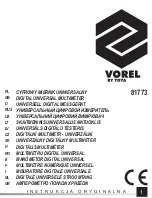
AUBER INSTRUMENTS
WWW.AUBERINS.COM
2017.01
P3/5
Psb1
PSb1
Input Offset 1
-1000 ~ 1000
0
4
Int2
Int2
Input type of Channel 2
2
See Table 3
Cu50
1
Dot2
dot2
Decimal Point Position 2
0000 ~ 0.000
0
2
Pul2
PuL2
Scale Low 2
-1999 ~ 9999
3000
3
Puh2
PuH2
Scale High 2
-1999 ~ 9999
4000
Psb2
PSb2
Input Offset 2
-1000 ~ 1000
0
4
C-F
C-F Temperature
Unit
1 & 2
C, F
C
Filt
Filt
Filter Coefficient
0 ~ 3
0
5
End
End Exit
Note 1
. All 19 input types are available to Channel 1. The 375R, 10 mA, 20
mA, and 4 - 20 mA input types are not available to Channel 2.
Note 2
. Dot parameter does not work for temperature input sensor
(thermocouple, RTD). Thermocouple will be displayed as integer (XXXX). RTD
will be displayed with 1 decimal place (XXX.X).
Note 3
. Only valid for input types that are neither TC nor RTD.
Note 4
. Display Value = gauge r
PSb
. Only valid for TC and RTD
signals. To enter negative value, please use shift key to shift to first left digit,
then use UP and DOWN key to scroll to the negative sign.
Note 5
. Digital Filtering Coefficient: 0, no filter; 1, weak; 2, medium; 3, strong.
Table 4. Input type options.
Symbol
Input Type
Gauge Range
Resolution
Accuracy
Impedance
T
TC, Type T
-200 ~ 400 °C
1 °C (°F)
0.3 %
100 K
R
TC, Type R
-50 ~ 1600°C
1°C (°F)
0.3 %
100 K
J
TC, Type J
-200 ~ 1200°C
1°C (°F)
0.3 %
100 K
Wre
TC, WRe3/25
0 ~ 2300°C
1°C (°F)
0.2 %
100 K
B
TC, Type B
260 ~ 1800°C
1°C (°F)
0.2 %
100 K
S
TC, Type S
-50 ~ 1600°C
1°C (°F)
0.3 %
100 K
K
TC, Type K
-200 ~ 1300°C
1°C (°F)
0.2 %
100 K
E
TC, Type E
-200 ~ 850°C
1°C (°F)
0.2 %
100 K
P100
RTD, Pt100
-199.9 ~
600.0°C
0.1°C (°F)
0.2 %
(0.2 mA)
Cu50
RTD, Cu50
-50.0 ~ 150.0°C
0.1°C (°F)
0.5 %
(0.2 mA)
375R
375
Ω
, Pressure *
the display
values
can be set to any
range within
(-1999 ~ 9999)
16 Bit A/D
0.2 %
(0.2 mA)
75mv
75 mV
0.1 %
100 K
30mv
30 mV
0.1 %
100 K
0-5v
0 - 5 V
0.1 %
100 K
1-5v
1 - 5 V
0.1 %
100 K
10v
0 - 10 V
0.1 %
100 K
0-10
0 - 10 mA *
0.3 %
150 K
0-20
0 - 20 mA *
0.2 %
150 K
4-20
4 - 20 mA *
0.2 %
150 K
(TC: thermocouple. RTD: resistance temperature detector.)
Note
: * These sensor types are not available to channel 2.
D.1.b) The Procedure of Setting Basic Parameters
(see Figure 5).
To set or view Basic Parameters, press SET key once, the upper window will
display “pass” and the lower window will display “0000”. Change the number to
“0089” in the lower window and press SET again to enter the Parameter
Setting Mode. Two parameters from the parameter list will be displayed. The
upper window will flash the first parameter, the lower window will steadily
display the next parameter on the list (see table 3). Use UP or DOWN key to
scroll to the desired parameter (flashing in the upper window) and press SET to
view the value. For numerical values, use SHIFT key to go to any digit that
needs to be changed and use UP or DOWN key to change the value. For letter
values, use UP or DOWN key to select from available values. Then press SET
to save and exit to the parameter list. To exit this mode, use UP or DOWN key
to scroll to “End” (flashing in the upper display window) and press SET. See
Figure 4 for a schematic diagram of how to change Basic Parameters.
PV2
PV1
dot1
Int1
PuL1
dot1
Int1
End
0-5v
Int1
0000
PAS S
SET
SET
enter code
0089
UP key
SET
Basic Parameter
Setting Mode
SET
Normal
Operating Mode
Figure 5. Schematic diagram of how to set Basic Parameters.
D.2 Alarm Parameters
(Press SET Key and enter 0001 to enter setting mode)
D.2.a) Alarm Parameters and Alarm Relays
Relay J1 and J2 are normally open (NO) relays associated with alarm settings
of Channel 1 and Channel 2 respectively. Each relay has two alarm
parameters
AH
and
AL
. The parameter
AH
(
AH1
for Channel 1, or
AH2
for
Channel 2) is the relay pull-in temperature, and the parameter AL (
AL1
for
Channel 1, or
AL2
for Channel 2) is the relay drop-off temperature. The range
for each alarm parameter is shown in Table 5. If
AH
>
AL
, relay acts as a high
temperature alarm relay; if
AH
<
AL
, relay acts as a low temperature alarm
relay; if
AH
=
AL
, the relay/alarm is disabled. Please see Note 6, Figure 7, and
Figure 8 for details.
Table 5. Alarm Parameters.
Symbol Name Description
Range
Initial Note
AH1
AH1
J1 on
-1999 ~ +9999
800
6
AL1
AL1
J1 off
-1999 ~ +9999
900
AH2
AH2
J2 on
-1999 ~ +9999
800
AL2
AL2
J2 off
-1999 ~ +9999
900
Note 6
. Relay Action Setting.
For either J1 or J2 relay:
1). When
AH
=
AL
, relay is disabled.
2). When
AH
>
AL
, relay is set as high limit alarm (see Figure 6).
3). When
AH
<
AL
, relay is set as low limit alarm (see Figure 7).























